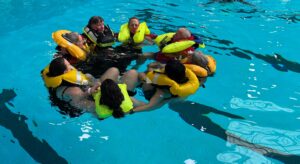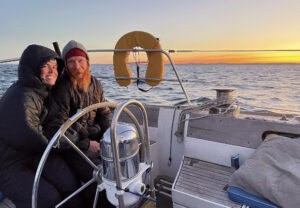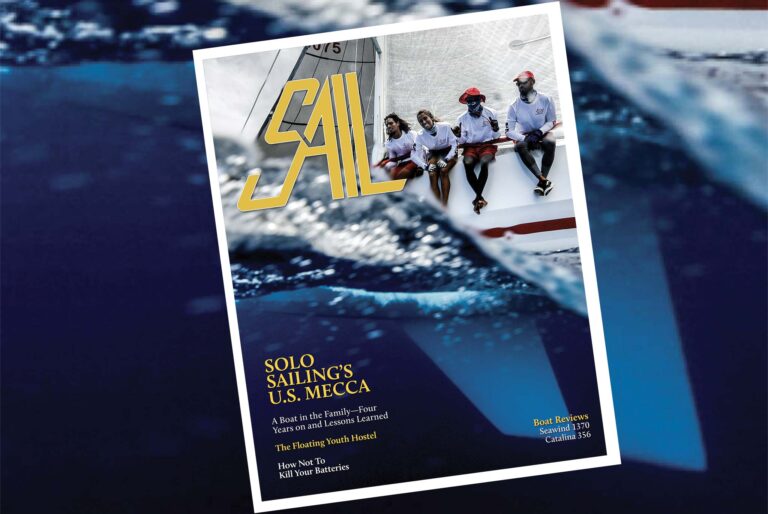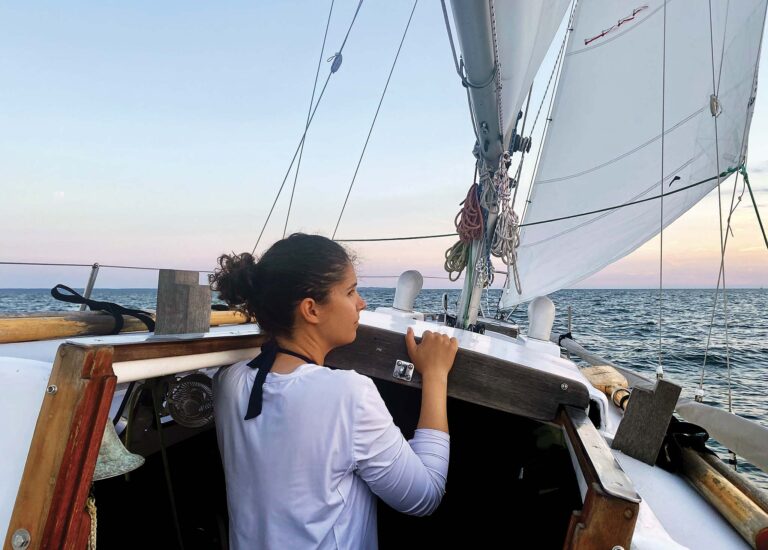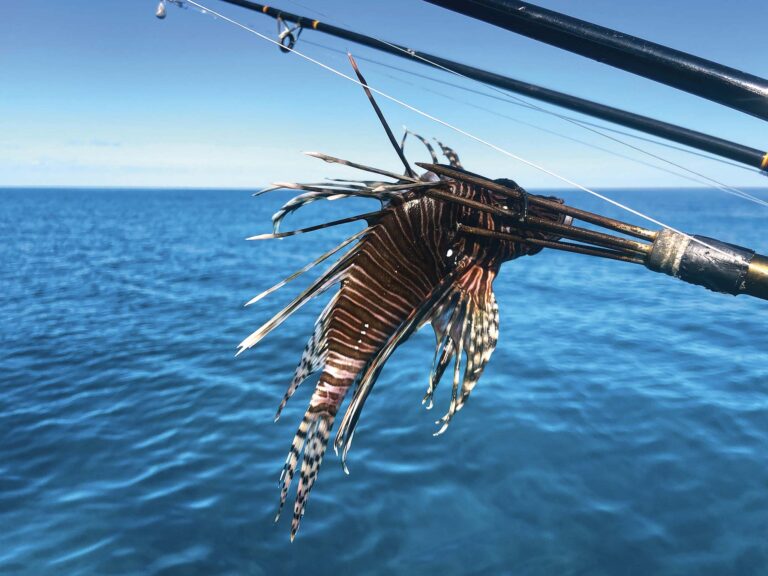
As David Tunick explains it, his sailing evolved over time. “I’m not a great sailor,” says the art dealer, 78, with a self-effacement that typifies his storytelling. “I wasn’t raised in junior sailing. I wasn’t in any yacht club, and it took me years to get into the Cruising Club of America.”
Tunick was exposed to boating at a young age, but he didn’t embrace sailing until adulthood. When he was 3, his bachelor uncles had a small model boat built for him. “One of my uncles took me to a park, I got in it, and it immediately sank,” Tunick says. But boating became a passion when his father and uncles took him aboard a 30-foot Wheeler. “There was nothing I wanted to do more every single weekend,” he says.
After graduating from college in 1966, he bought a used wooden Lightning and used it to sail alone or with friends across the Sound from Greenwhich, Connecticut, to Oyster Bay, New York, to overnight on the beach. Then he got a call from the harbor master that his boat had sunk. “I sold it to a guy while it was still sunk,” he recalls. But when he later saw the boat sailing out of Indian Harbor in Greenwich, he “felt a pang of regret and jealousy.”
For the next decade he built a business selling 15th- to mid-20th-century prints, drawings and paintings by artists like Rembrandt, Goya, Matisse and Picasso, which he continues to do from a town house on Manhattan’s Upper East Side. “I didn’t have time to go boating for about 10 years because I worked weekends and all summer,” Tunick says.

A decade after selling the Lightning, Tunick bought a German-built Sparkman & Stephens 40-foot yawl. He named her Thunderbolt and for the next 6 years he sailed her to Cape Cod, Bermuda and Maine. He loved Maine so much that he bought a house in Southwest Harbor, but when he and his wife had their second child, Tunick wanted a bigger boat.
He found a beautiful 54-foot, 8-inch Sparkman & Stevens-designed, aluminum-hulled yawl on the West Coast. She had been built in 1967 by the renowned Abeking & Rasmussen yard in Lemwerder, Germany. Tunick looked at the yawl for 3 years. He felt the cockpit was too big and the coamings too low, but he kept returning to the big yawl, sailing her twice, even as she changed hands. David Fraser, the yawl’s broker, told Tunick that the owner, a movie producer, used her maybe twice a year to take stars like Barbra Streisand and Sean Connery sailing.
The yawl was way more money than Tunick could afford, but then he had an unexpected windfall. He owned a work of art by Maurice Prendergast, an American post-Impressionist painter, and an avid collector had been chasing it. Tunick told the collector it wasn’t for sale, but he kept increasing the offer and it finally got so absurdly high that Tunick said OK. After he sold the painting, Tunick immediately called Fraser and told him, “I can’t afford the boat’s asking price, but this is what I have in my account today.” What Tunick offered was half the asking price. Fraser told Tunick he’d get back to him. “It took him about 12 minutes,” Tunick says. “I wired him the money. That was 1984. I’ve now had the boat for 39 years.”
The yawl was trucked across the country, but then he got a call from Rives Potts, who at the time was the general manager at Pilots Point Marina in Westbrook, Connecticut. “The good news,” Potts told Tunick, “it arrived on time. The bad news, we made a mistake and the boat fell over.” Some of the winches and teak had broken, but Tunick credits Potts for starting the repairs without insurance money. Amazingly, Abeking still had wood from the same tree that was used in the yawl’s 1967 build.
Tunick renamed the yawl Night Watch, for the famous Rembrandt painting and for the watches Tunick stands at sea. What he hadn’t realized when he went into the art world in 1966 was that he’d entered a seasonal business. “It’s like an academic year,” Tunick says. “In the summer, the collectors and museum people go away. They go to the Hamptons, Nantucket, the Vineyard, Maine and Europe.” It is a schedule that has allowed Tunick a life full of sailing.

As soon as Night Watch was repaired, Tunick headed for Maine. Every summer thereafter, he’d sail her there, and every fall he’d sail her to the Caribbean with his kids or clients. “I’d sail to Bermuda from October 15 to November 1, come back to work, fly back to Bermuda and sail it to Tortola or the USVI,” he says. But when condominiums and marinas started popping up on Mount Desert Island, Tunick sold the house in Maine.
By then, he was involved at the New York Yacht Club, where he was put in charge of the model committee. “I knew less than anybody on that committee,” Tunick says. “I was on it with Bruce Kirby, Dan Nerney and Dick Goebbel, who knew way more than I did.” But using his art experience, Tunick got the model room catalogued and properly organized.
Tunick was also in charge of leading a group of NYYC boats to the 2001 America’s Cup jubilee in England, which was the ostensible reason for his first transatlantic crossing, but by then he’d already developed an appetite for singlehanding. He found solo sailing forced him to depend on himself and also gave him a sense of freedom. “I find sailing singlehanded liberating. l don’t have to worry about others falling overboard or making mistakes,” he says. “I make a lot of mistakes, but I usually recognize them pretty quickly, and there’s nobody to blame but myself.”
Friends tried to discourage him from singlehanding. “It’s not hard to know more than I do,” Tunick says without a hint of embarrassment. He understood their concern, but by then he’d already made three singlehanded passages to Bermuda, completed shorter passages on his own, and made longer passages with crew from the Northeast to the Caribbean. He never wavered from his intention to cross the Atlantic alone. He left on Friday, July 13. “I violated all kinds of taboos in sailing,” he acknowledges.
After 2,000 miles and 17 days he wrote friends from sea that the passage was “terrific,” even though by that point he’d encountered enough challenges to make most people quit. His radar conked out, the spinnaker halyard broke, the generator died, and a steering gear failure disabled the autopilot, which required a five-hour nighttime repair while Night Watch got pounded in heavy seas. Despite the problems, he ate well, got enough sleep and enjoyed visits from porpoises, marine birds and the occasional Monarch butterfly. After 22 days at sea, he sailed into Falmouth’s harbor on a beautiful reach, having sailed the 3,000 miles to England alone.
Once across the pond, Tunick was joined by friends, sailed in the jubilee, and quickly found himself racing in other classic boat regattas. He raced in the Solent out of Cowes, in Scotland’s Hebrides, in Denmark and Sweden. Tunick says he wasn’t looking to race. “I do that at work,” he says. I want the boat to be a place for relaxation.” But he found he liked the camaraderie and the social events in Europe’s classic divisions.
Tunick thought he’d be in Europe for maybe two or three summers, but when he reached Scandinavia in 2003, he found the people to be fun and the scenery so beautiful that he cruised and raced in all the Nordic countries. Most summers he’d get to the boat in late June and fly back a day or two after Labor Day. Through his involvement with the North American Station to the Royal Scandinavian Yacht Clubs, Tunick organized cruises to the Stockholm Archipelago, the West Coast of Sweden, Denmark and the Finland Archipelago. “When I was in charge of a cruise, I would spend summers exploring every anchorage I could find that could accommodate a fleet or was spectacular,” Tunick says. He’d float around where the depths weren’t charted, go out in the dinghy and drop a lead line. He spent more than half of his European summers in Scandinavia. “I fell in love with the topography, the waters and the people,” he says. “The west coast of Norway, where the most dramatic fjords are, is one of the most beautiful places I have ever sailed,” he says. “And the Stockholm Archipelago is unparalleled. It’s one of the reasons I spent so much time in Sweden.”
But he ventured elsewhere, too. He initially thought the North Sea was nothing but a curse until he discovered the Dutch Wadden Islands. And he loved France’s Brittany coast, where he saw the places he only knew from impressionist paintings by Monet and Signac. “I loved all of it. All of it,” Tunick says.
Before the pandemic he had stored Night Watch indoors in the Netherlands, but without consulting him, the yard moved her outside, where rainwater infiltrated her bilges and engine. In 2009 Tunick had replaced the boat’s 60-horsepower Westerbeke with a 100-horsepower Yanmar, but now that engine had to be rebuilt. In the summer of 2021, with a small crew, he sailed the boat 1,000 miles to A Coruña on Spain’s northwest corner to prepare for a 2022 crossing to the States.
He had the generator rebuilt, renewed the standing and running rigging, replaced both autopilot brains and added redundant systems. “It would be a slight exaggeration to say that all I did was deliver my boat,” Tunick says. “It takes three years to prepare your boat and your body for a long delivery.”
Back in the states, Tunick had taken cooking lessons and learned how to make pasta and sauce in three minutes. For provisions, he bought fresh oranges and grapefruit that he knew would stay fresh as long as they weren’t refrigerated and stocked up on quality canned foods.

“If it was too hot to cook, I’d open a can of sardines or Tikki Masala or something else, and it would be great,” he says. “You have to nourish yourself and take care of yourself at sea.”
Tunick rarely drinks alcohol and never offshore. He’s never had a cup of coffee in his life, although he admits to having an almost uncontrollable appetite for chocolate. He bought 24 bottles of chocolate milk at a supermarket in Spain and filled one of Night Watch’s really big lockers with chocolate bars, Kit Kats, M&Ms and other sweets. “It’s not unknown for me to have six or eight big glasses of chocolate milk in one day,” he says.
He intended to cast off on June 4, 2022, but things literally got off to a bad start when he pushed the ignition button and the engine failed to turn over. Water had entered the engine after one of the 10-liter muffler pots below the waterline had apparently been unable to handle backwash surge. Mechanics replaced the 10-liter pots with 25-liter pots, and a week later Tunick set off for America.
On the third day at sea, the autopilot stopped working. He hand-steered, but then the boat refused to turn to port. Then the bilge pumps got balky and the generator refused to start. The steering problem sorted itself out, Tunick got the bilge pumps going again, and four days later made it to the Azores. But as he entered Horta’s harbor the steering seized up again. He was forced to anchor outside the harbor for a night on a lee shore in very nasty conditions until the harbor master finally sent assistance. Once docked, he discovered that a seized stainless-steel ball joint had caused the intermittent steering problem. Since there were no 12-volt bilge pump replacements available on Horta, Tunick purchased 24- and 110-volt pumps.
But none of the problems kept Tunick from going to sea. He departed Horta but five days later found himself becalmed in an Azores High. He would have motored to find wind, but the engine wouldn’t start. He’d had a new starter motor installed in Spain but within weeks the non-OEM starter had corroded so badly that it stopped working. Tunick had a spare aboard but replacing it was a two-man job. Then the electrical problems began. Even though he had nine new batteries, Tunick found he had to run the generator for unusually long hours to barely keep them charged. All the while, he was drifting with little or no wind while roasting inside the aluminum hull, his only refuge from the beating sun. To get some relief, he would run a fan for a few minutes and pour water over his head. He only went up on deck at dawn and dusk and stood watch at night because he couldn’t afford to run his navigation lights. Tunick had trained himself years before to fall asleep in a matter of seconds and sleep in 6- to 8-minute stretches, which is what he did for most of the voyage.
When the wind finally showed up, the autopilots got balky. Tunick tied off the helm and balanced the rig so Night Watch would steer herself. “When all else fails, you have to depend on your boat and have complete confidence in it,” Tunick says. “And I have a great boat.”
Next, gale force winds were predicted ahead. Tunick made a sharp left to get around them, but with the engine dead, the generator balky and the batteries low, he had to turn all the electronics off to conserve power. Eventually he identified a faulty connection on the generator, which allowed him to fire up the navigation lights, GPS, AIS, wind instruments, radio and internet again.
Then, just when he was back in business, Tunick backed the sails just long enough to cause the autopilot to lock the rudder in place. For the next 22 hours he worked with CCA member Steve James via WhatsApp to fix the steering while Night Watch drifted east in her disabled state.
Tunick hadn’t formed a shore team before leaving Spain, but whenever he needed help one of his many sailing friends from the CCA, NYYC or Stamford Yacht Club would answer a call or an email to help him figure things out. He was blown away by James’ intricate knowledge of the autopilot system. When James told Tunick to take a particular nut off the autopilot arm, James warned him not to drop it in the bilges and to look for the white piece of plastic inside the nut. “I thought, ‘how does he know that?” Tunick says. “He was of tremendous help, and he always made time for me.”
Even when he got underway again and unfavorable winds kept him from his destination, Tunick remained upbeat. In an email to friends and family, he reported all the challenges he faced and concluded by writing: “Hey, that’s yachtin’. It’s still mostly one beautiful day after another on the high seas, and as far as I’m concerned, what could be better?”
Nearly a month after leaving the Azores, having covered 1,800 miles, Tunick spotted the bright flashing light of Bermuda’s St. David’s Lighthouse. After drifting engineless in the opposite direction of where he wanted to go, in intense and windless heat, and sometimes going in almost complete circles for days at a time, he was finally headed for the narrow cut into St. George’s Harbour.
Tunick had never intended to get anywhere near Bermuda. He had charts on board for every island in the Caribbean and the entire East Coast of the United States, but the Bermuda charts were under his bed at home. All he had for Bermuda was a 1988 tourist road map. He hadn’t been to Bermuda in 25 years, but he knew that the place was surrounded by reefs, rocks and shallows. A friend texted photos of Bermuda charts to Tunick’s iPhone, which allowed him to get to the channel. There he doused the sails and waited for a towboat to bring the powerless Night Watch into the harbor.
His primary objective in Bermuda was to get the engine running again. He replaced the starter motor with an OEM version and got the engine humming. The generator was still down—probably for good—and the autopilots were still hinky, but a mid-summer, four-day holiday prevented repairs. So, in late July he set off to cross the Gulf Stream, where two more challenges would await.
During a Gulf Stream blow, an asynchronous wave threw him across the boat. He suspected he had broken some ribs and his right hand. For the rest of the passage Tunick’s left arm was partially impaired. But his rosy outlook kicked in again. He had read an article about guys who were amputees who sailed the oceans. “I thought, what I’ve got is nothing. So, I can’t use my my left arm or right hand for a while? Big deal. I’ll get better.”
When the wind died on Long Island Sound, Tunick fired up the engine only to find that the battery voltages were running too high, causing systems to shut down from overload. One battery and a thick cable were hot, so he flipped on everything that might draw some power out of the batteries, kept the Yanmar at low rpm, and continued on his way.
About 5 miles west of Norwalk, Connecticut, Tunick was greeted by a small fleet of boats. As he neared Stamford, the flotilla grew as a boisterous group of Stamford Yacht Club members blew their boat’s horns, fired a cannon and sprayed champagne.
It took Tunick two months to cross but he has no regrets. He says floating around in the Azores High was the low point. He lost 20 pounds there and admits envying his partner of 12 years when she FaceTimed him from her air-conditioned bedroom while he was in the inferno. “I sweated,” he says. “But I would be very reluctant to say I suffered. Heck I’m on a boat. Nothing makes me happier than to be afloat on a boat.”
Tunick says he was mesmerized by the beauty of being at sea. “On some days I saw the full moon rise at the same time as the sun was setting. One in front of me and one behind me,” he says. “I am not spiritual, but that felt spiritual.” And in terms of wonderment he says it was the Milky Way that blew him away. “In the dark of the sea, it lights up and sweeps across the sky like a super-highway,” he says.
He never opened one bottle of chocolate milk, nor did he touch the Kit Kats or M&Ms. “I lost the sweet tooth,” he says. He is mystified as to why, but he says it came back on land.
Tunick may now be the oldest person to sail the Atlantic singlehandedly from east to west. The Guinness Book of World Records asked him to apply but he hasn’t because he didn’t do it to set a record. “I singlehanded back because I wanted to from the day I arrived in England on Night Watch in 2001.”
Recently, the Cruising Club of America awarded Tunick the Far Horizons Award for his two transatlantic solo passages, but he is excited to be back in Long Island Sound. “I didn’t think about that until I went through The Race and all those swells were gone,” he says. “It has so much to offer.” He plans to go back to his former routine by sailing up to Newport, Cuttyhunk, the Vineyard, Nantucket and over to Nova Scotia. But he also wants to singlehand back to Spain, and he would like to sail back to Ireland. “I might do that in a few years,” he says.
This article was originally published in the May 2023 issue of Soundings magazine.

